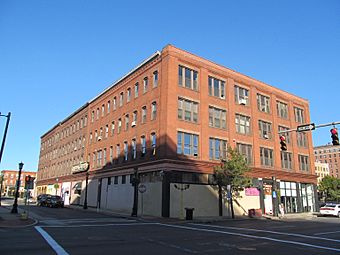Baystate Corset Block facts for kids
Quick facts for kids |
|
|
Baystate Corset Block
|
|

Baystate Corset Block
|
|
| Location | 395-405 Dwight St., 99 Taylor St., Springfield, Massachusetts |
|---|---|
| Area | less than one acre |
| Built | 1874 |
| Architect | Robinson Marsh & Co. |
| MPS | Downtown Springfield MRA |
| NRHP reference No. | 83000737 |
| Added to NRHP | February 24, 1983 |
The Baystate Corset Block is an old building in Springfield, Massachusetts. It's located at 395-405 Dwight Street and 99 Taylor Street. This building was built in 1874 and was made bigger two times. From 1888 to 1920, it was home to the Baystate Corset Company. This company was one of the biggest in the country that made corsets. A corset was a type of clothing worn in the past, often to shape a person's figure. The building was recognized as an important old place in 1983.
What is the Baystate Corset Block?
The Baystate Corset Block is in the northern part of downtown Springfield. It sits at the corner of Dwight and Taylor Streets. The main part of the building faces Dwight Street. It was built in 1874 by a company called Marsh & Robinson.
Building Details
This building has four stories and is made of brick. The original design can still be seen on the side. It has windows with rounded tops and decorative brickwork near the roof. The front of the building was updated in 1918. The upper part of the front has five sections. Each section has three windows, separated by brick columns. The shops on the ground floor still look much like they used to.
A Look at Its History
The first businesses in the building were shops that worked with wood. They stayed there until 1883. Then, a company that made paper products moved in. The owner, P. P. Kellogg, made the building bigger. He added a new part along Taylor Street in 1888.
In 1886, the Baystate Corset Company rented some rooms in the building. This company had started two years earlier in West Brookfield, Massachusetts. Baystate grew very quickly. They bought the entire building in 1895. The company stayed there until 1920.
At that time, Baystate was one of the largest corset makers in the United States. They sent their products all over the country. The top floor of the building was used for cutting fabric. The second and third floors were filled with sewing machines. This is where their clothing products were made.
Images for kids




